Summer 2018, we visited Palermo to join the opening of Manifesta 12 event on Sicily. We stayed in Palermo between Thursday June 14 and Sunday 17. The weather was not as warm as expected, but great for a city trip. After this weekend we stayed a week in Cefalu, a bit east of Palermo. Read about that week here later.



Manifesta is a nomadic biennial of contemporary art & culture that changes location every 2 years.
(More on Manifesta 12 on m12.manifesta.org and manifesta.org.
The City of Palermo was important for Manifesta’s selection board for its representation of two important themes that identify contemporary Europe: migration and climate changes and how these issues impact our cities. The multi-layered and deeply condensed history of Palermo – being occupied by almost every European civilization and having long-term connections with Northern Africa and the Eastern Mediterranean over the last 2000 years – has left its traces throughout this multi-cultural society at the heart of the Mediterranean area.

Hedwig Fijen, Manifesta Director:
“Manifesta 12 in Palermo is a great challenge to rethink how far cultural interventions can play a role in helping re-shaping one of the most iconic Mediterranean crossroads in our history as part of a long term transformation process. Manifesta 12 will raise questions such as: “Who owns the city of Palermo?” and “how to claim back the city?“ The city’s migration problems are symbolic of the far wider crisis situation which the whole of Europe is facing right now.”

Leoluca Orlando, Mayor of Palermo:
“Manifesta 12 in Palermo in 2018 will be a fantastic opportunity for the city to reinvigorate its local and international identity. It is a moment for Europe to appreciate the significance of its Mediterranean dimension and identity: Palermo brings Manifesta to the Mediterranean and the Mediterranean to Europe. Manifesta 12 is an opportunity to celebrate Palermo for what it really is: a laboratory for the humanities, arts and culture. The city will be able to renew itself and pave a way for its future.”
Here a some of the highlights that we have enjoyed in Palermo.
Teatro Massimo
Piazza Verdi, Palermo
teatromassimo.it

The Teatro Massimo Vittorio Emanuele is an opera house and opera company located on the Piazza Verdi in Palermo, Sicily. It was dedicated to King Victor Emanuel II. It is the biggest in Italy, and one of the largest of Europe (the third after the Opéra National de Paris and the K. K. Hof-Opernhaus in Vienna), renowned for its perfect acoustics.
Bintou were, a Sahel Opera


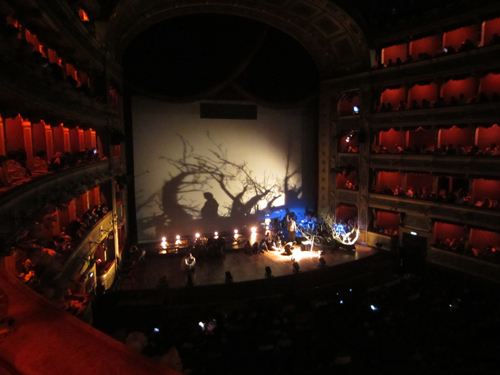



Bintou were, a Sahel Opera (abridged version) is an opera made and produced in the Sahel. The opera project was initiated by the Dutch Prince Claus Fund and premiered in Africa and Europe in 2007/2008. It is restaged for Manifesta 12 Palermo in Teatro Massimo with the addition of local elements including a local choir composed of African singers trained by the local conservatorium. On June 15, 2018, the opera was staged in Teatro Massimo, Palermo, and simultaneously screened on Piazza Verdi.
Palazzo Butera
via Butera 18, Palermo



Palazzo Butera is located in the historical Kalsa neighbourhood. Although its original structure dates to the end of the 17th century, it did not acquire its current architectural configuration until the mid-18th century. The palace belonged to the noble Branciforte family, who later received an endowment from the Princes of Butera. In 1737, Prince Ercole Michele Branciforte sought permission from the Palermo Senate to build a terrace on Strada dei Cattivi in order to harmonize his building with the two adjacent buildings, which jutted out sixteen palms beyond his. After a fire in 1759 that destroyed much of the interior, the prince initiated an expansion project, renting a palace on Piazza di San Niccolò owned by the Benso family, Dukes of Verdura and purchasing the palace of Francesco Moncada, Count of Caltanissetta. By the end of this work, Palazzo Butera’s monumental size was second only to the Royal Palace of Palermo. In 2015, the palace was acquired by Massimo and Francesca Valsecchi, who initiated a major self-financed restoration.
Fallen Fruit, Theatre of the Sun (2018)
fallenfruit.org
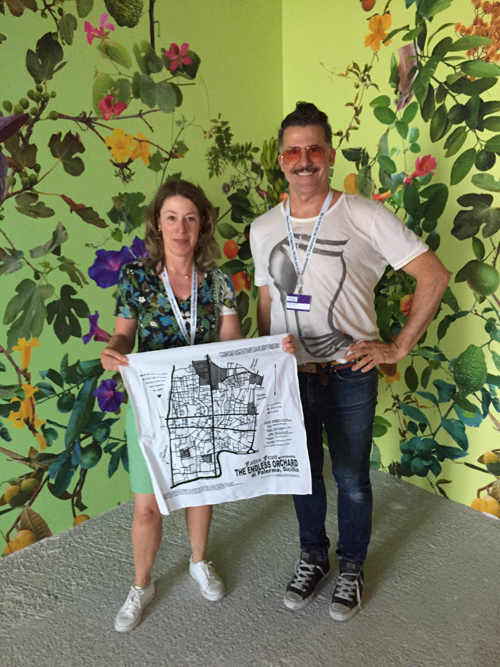
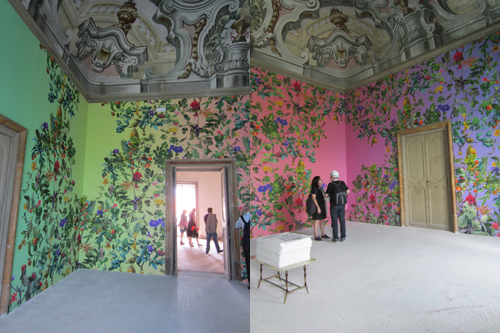



Fruit, like culture, moves around the world with territorial expansion, transnational trade, and human migration. Seeds are carried by the winds, in the linings of clothing, or in cargo, inadvertently. Fruit is not only natural, it is also a cultural object, even ‘political’. This is especially evident in the port city of Palermo.
Theatre of the Sun is composed of an immersive art installation of wallpaper and maps of fruit trees growing in the city, providing abundant edible fruits to all. The Public Fruit Map of Palermo indicates the location of hundreds of fruit trees in public and private spaces that are often overlooked and ignored. The maps are available for free use, as the fruit trees become a shared resource. The Palermo Public Fruit Map is part of the Endless Orchard, and expanding global resource, mapping edible fruits in public spaces in cities around the world. The artwork articulates a contemporary point of view about transient and ancient public spaces, which continue to preserve local history and persist in recreating themselves anew.
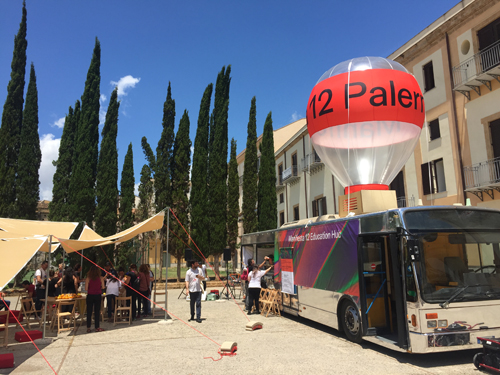

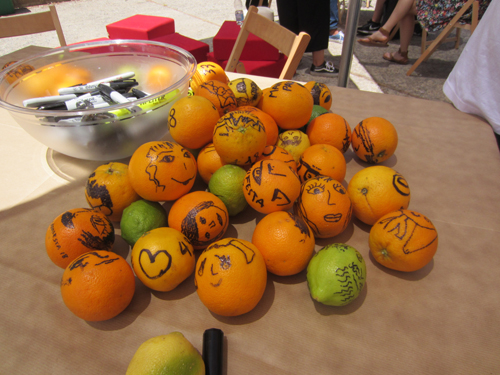
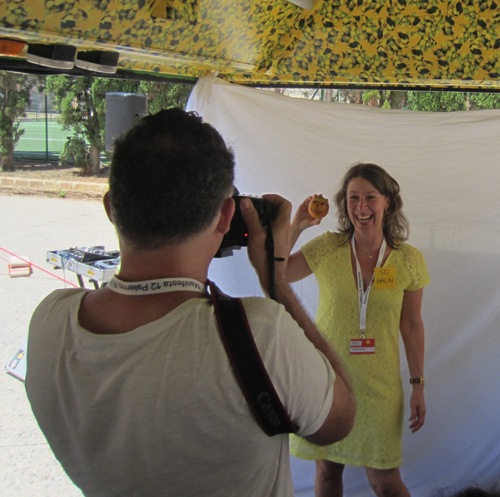
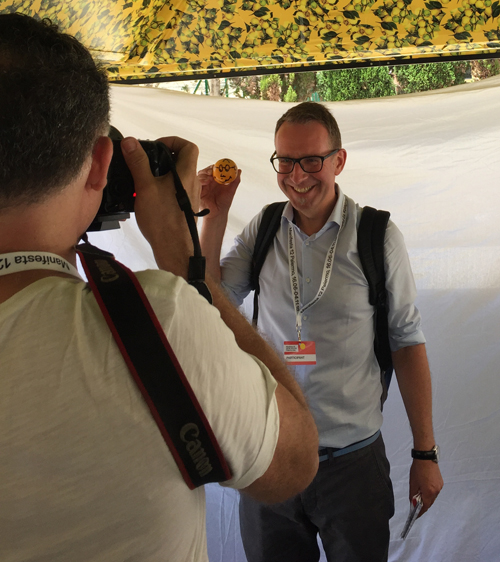

Renato Leotta, Giardino
www.renatoleotta.it


Notte di San Lorenzo is an environmental work that creates a relationship between a portion of the citrus garden and the space of a hall in Palazzo Butera. The two environments (respectively ideal and real) blend in a single mental landscape, generating a dialogue on the circumstances that connect time and space by means of gravity. The clay tiles installed on the room’s floor record the dropping of the lemons from the trees. The fruit, drawn to the ground by ripeness, weight or strong gusts of wind, forms a constellation of signs that bear witness to one phase in the life cycle of the garden. The floor, like the rest of the decorative architectural elements, underlines the relationship between ‘palace’ and ‘feud’.
Maria Thereza Alves
www.mariatherezaalves.org

Maria Thereza Alves, Una proposta di sincretismo (questa volta senza genocidio) (2018), installation
In collaboration with: Antonio Josè Pantuso (Le Stanze del Gattopardo)
The project began with a few antique tiles of exotic parrots from Brazil seen in the flea market of Piazza Marina. They were remnants of a common motif in Palermo called ‘Birds of Paradise’, consisting of non-local and local birds on the corners of a panel celebrating an event such as a new castle or house.
The project alludes to the present foodscapes and landscapes of Sicily where the prickly pear and agave from Mexico, tomatoes and potatoes from the Andean region and the Jacaranda and Ceiba speciosa trees from Brazil come to form a new syncretism that has been incorporated by Sicilians at times in contemporary definitions of the region. It also alludes, of course, to the parrots from Brazil that were smart enough to escape from their captivity for crimes never committed.
Uriel Orlow
urielorlow.net
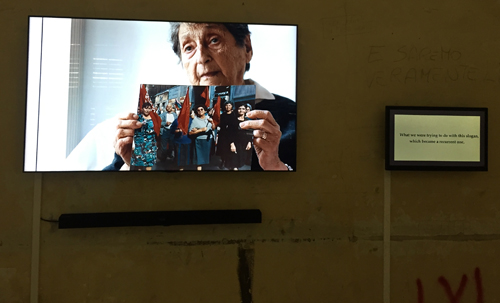
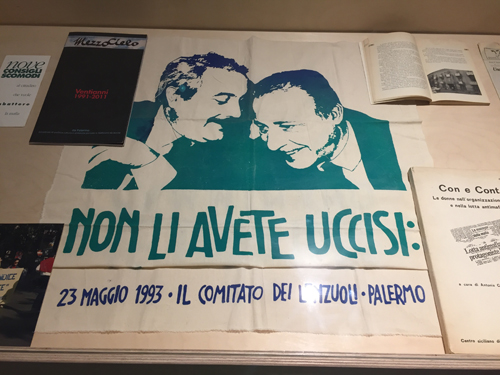
Commissioned by Manifesta 12 Palermo, Uriel Orlow’s project is titled Wishing Trees, a video installation that connects human histories and nature. Specifically, Wishing Trees brings together the stories of three Sicilian trees that hold memories of significant events and people. Through contemporary stories of conflict, migration and anti-mafia activism, the roots of these trees reach into the present. Uriel Orlow’s evocative multi-part installation weaves together narratives of present-day protagonists in Sicily with the hopes and desires the trees still stand for.
Palazzo Forcella De Seta
Foro Italico Umberto I 21, Palermo



Palazzo Forcella De Seta is one of the most significant examples of nineteenth century eclectic architecture in Palermo.
The palace was originally the “casina a mare” (seaside house) of the Bonanno family, princes of Cattolica, who were in charge of securing the Vega bastion, part of the city walls. During the 1820 revolutions, the architectural complex underwent considerable damages, and consequently, it was completely reconstructed.
Patricia Kaersenhout, The Soul of Salt (2016)

Within the Caribbean tradition there is a slave legend according to which enslaved people refrained from eating salt, because they thought they would become lighter and could fly back to Africa. In spite of cultural differences, the widespread tale of the ‘Flying Africans’ reveals a common origin and a shared experience. It expresses the ability of people to flee in their imagination, which comes from the desire for freedom.
In the video, the mountain is blessed by a spiritual leader from the African continent. Visitors can take some salt home and dissolve it in water as a symbol for dissolving the pain of the past. A group of refugees sings a nineteenth-century slave song during the ceremony. This shows a connection between enslaved bodies transported over the ocean in the past and the contemporary refugee crisis.
In 2017 the artist flew back to Gorée Island in Senegal with some of the blessed salt, and released it at Door of No Return, a museum and memorial to the Atlantic slave trade, to grant peace to the souls of the ancestors.
Laura Poitras, Signal Flow (2018)
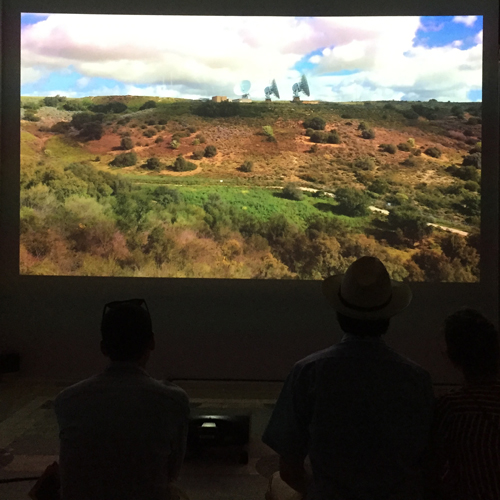
In a constellation of new works, Laura Poitras takes viewers on a narrative journey through the landscape and through economic aspects and their future developments underlying the U.S. military’s growing presence in Sicily. Sicily is a linchpin in the United States’ military communications and drone operations worldwide. For over three decades, Sicilian citizens of all ages have fought to stop the construction of this infrastructure. Through a site-specific immersive installation, a film clinic with local filmmakers and reporting by Henrik Moltke, Laura Poitras collaborates with citizens and artists to create a work that lives beyond the timeframe of the event.
Kader Attia, The Body’s Legacies. The Post-Colonial Body (2018) and Untitled (2018)


Kader Attia conducts research on the relationship between the individual and the social body, with a specific focus on the post-colonial body today. His interest lies in the question of what the body of enslaved or colonised people’s descendants has become, in a moment when a new disaster of bodily displacement is happening, namely the current refugee crisis. His film The Body’s Legacies. The Post-Colonial Body reflects on the repressed post-colonial body through interviews with four protagonists that are descendants of colonised people or slaves. The narration goes back and forth between individual experiences and wider analysis, with a focus on a particular story as a pivot: the aggression on young Théo Luhaka that happened in February 2017 in a Parisian suburb. The young man was beaten and raped with the truncheon of one of the policemen arresting him. Kader Attia’s film builds a counter-narrative to the Western hegemonic racist national one, setting out to prevent erasure of the violence that is perpetrated in a so-called democracy, and documenting the struggle of those who resist. In addition to the film, Kader Attia presents a sculpture, Untitled, made of a cracked piece of wood repaired with traditional staples, that appears as a metaphor of a fragile human being.
Forensic Oceanography, Liquid Violence (2018)


Since 2011, Forensic Oceanography has been critically investigating the spatial and aesthetic conditions that have turned the Mediterranean into a militarized border zone, leading to the death of large numbers of migrants. Liquid Violence (2018) brings together three investigations conducted over this period. Liquid Traces (2014) charts the trajectory of a boat abandoned at sea during NATO’s 2011 military intervention in Libya; Death by Rescue (2016) reconstructs the lethal effects of the decision made by Italy and the EU to cut back search and rescue activities at sea; Mare Clausum (2018) concerns the two-pronged strategy currently implemented by the Italian government to close off the sea: on the one hand, criminalizing the rescue activities of NGOs, on the other, supporting Libyan actions to prevent and intercept departures. Each of these works seeks to analyse and contest a particular mode of border violence, all the while drawing a political anatomy of the fluctuating patterns of border control and (non-) assistance at sea, and their dramatic consequences for the lives of migrants.
Archivio di Stato di Palermo, Sede della Gancia
Cortile I della Gancia 2, Palermo
www.archiviodistatodipalermo.it





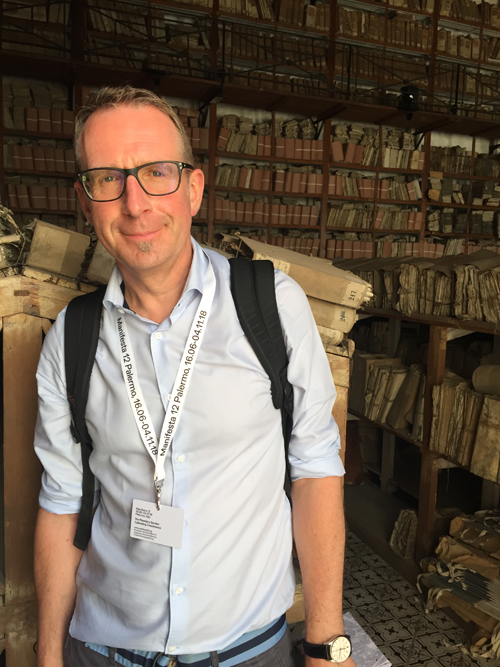
Masbedo, Videomobile (2018)


Videomobile is an old van transformed as a ‘video wagon’ that roams the locations of cinema of the past, investigating the Sicilian society and the history of the Palermo territory, with a particular accent on themes like power and its dynamics, the genius loci, and the struggle for ideals. The artists, always involved in the visual arts, have chosen to break down the complex language of cinema through the medium of video. Videomobile thus becomes a laboratory in motion that functions as a workspace but also as a stage for performances produced during Manifesta 12 in spaces like the Archivio di Stato, the Arena at Mondello and Teatro Garibaldi. When the van is parked, it becomes an interactive video installation with monitors and screens that form a narrative device.
Orto Botanico
via Lincoln 2, Palermo
www.ortobotanico.unipa.it
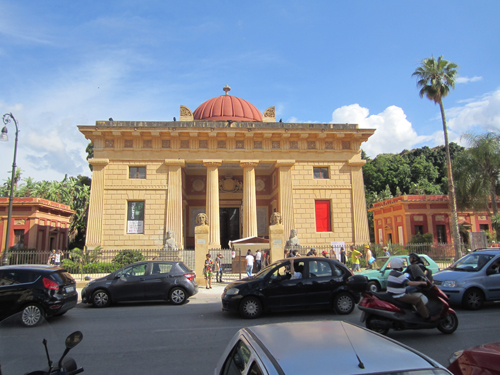


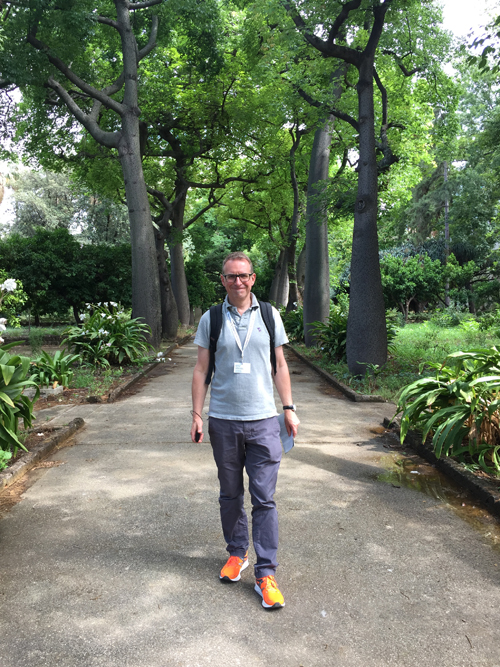




The Botanical Garden of Palermo, a key inspiration for the curatorial project of Manifesta 12, was planted in 1789 and inaugurated in December 1795. It was officially incorporated into the Accademia dei Regi Studi of Palermo when the school was founded in 1806, at which time the first Chair of Botany was instituted. The garden has grown since then, thanks to Palermo’s Botanical School, which helped it to gain recognition, expand, and enrich its collections. Organised into well-ordered and scientifically identified Collections, arranged according to aesthetic and landscape criteria, the Botanical Garden of the University of Palermo is broadly divided into various sections: Linnaeus’ Zone, Engler’s Zone, the Succulent Garden, the Mediterranean hillside, the Medicinal and Aromatic Plants Section, the Cycadetum, the Palmetum, and the Experimental, Biogeographical and Useful Plants Sections. The large circular pool (Aquarium) is of particular interest, with its twenty-four sections of varying depths and a surface area of approximately 500 square meters.
Alberto Baraya, New Herbs from Palermo and Surroundings. A Sicilian Expedition (2018)


The project of a herbarium of artificial plants creates a fake collection of Palermitan and Sicilian plants based on taxonomy. These plants have been gathered during indoor and outdoor expeditions around the city and across the island of Sicily, focusing on tributes and homages placed on altars made by local residents, visitors, migrants and travellers over time.
New Herbs from Palermo and Surroundings. A Sicilian Expedition envisions the installation of this peculiar collection at the Botanical Garden of Palermo, seeing its greenhouse as a perfect cultural and floral meeting point. A display made of artificial plants systematically represents behaviours of everyday life connected with the island’s cultural traditions and beliefs.
Zheng Bo, Pteridophilia (2016 – ongoing)


Pteridophilia explores eco-queer potential. Seven young men walk into a forest in Taiwan and engage in intimate contact with ferns. They make love with the plants, sensing each other’s textures, aromas, and pleasures. They rely on bodies rather than language to initiate affective relations. Ferns are abundant in Taiwan. They have been cherished by indigenous tribes, but overlooked by Japanese colonialists and immigrants from the mainland. Only when we extend our imagination can we learn to appreciate the complex existence of all living things. Only then will we learn to live more intelligently on this planet.
Lungiswa Gqunta, Lituation (2018)

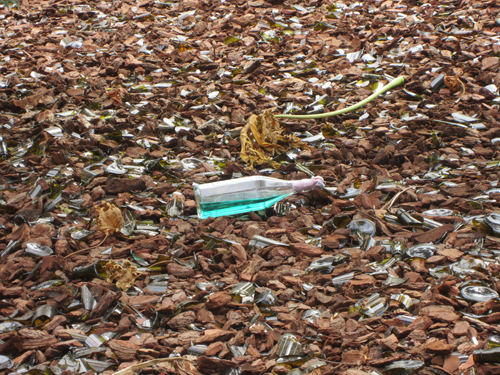
This installation seeks to interpret the garden as a stratified space complete with stories, sacred rituals, and memory. Our relationship to the land is tied to exploitative work but also to a sense of transcendence. In her installations, she uses familiar and domestic objects, which, when combined, become weaponry: beer bottles filled with petrol turn into weapons that suggest mobilization and acts of resistance.
The installation is composed of glass bottles and unleaded petrol which cover the entire floor of the Serra delle Papaie in the Botanical Garden.
Michael Wang, The Drowned World (2018)


The Drowned World is a work organised as two elements connected to the organic origins and current biological consequences of the phenomenon of industrialisation. A small decorative pool in the Botanical Garden shines with a greenish-blue light. A living monochrome, the pool’s colour is due to cyanobacteria, ancient organisms that were among the first to carry out photosynthesis using chlorophyll. Over two million years ago, their appearance launched the biological process through which light and air can transform into organic material. This process released substantial quantities of oxygen into the Earth’s atmosphere for the first time. As it was toxic for almost every form of life that had developed to that point, atmospheric oxygen caused the greatest mass extinction in the history of the planet. A forest, composed of plants closely related to those that existed in the Carboniferous Period, grows among the industrial ruins of an old gasometer. These plants once formed the enormous swamps that stretched across the entire planet. Over the centuries, their buried remains gave shape to the coal used in that very gasometer. When heated and burned, this coal re-releases the air that was captured more than 300 million years ago, thus restoring a primordial atmosphere.
Khalil Rabah, Relocation, Among Other Things (2018)


The project began with the artist’s interest in the city’s markets, where objects deriving from different contexts mix together to form a new sense of community. The artist has created a market of various handmade articles, assemblages, and sculptures at the Botanical Garden. Like the flora that populates the Botanical Garden, objects and different handmade items, assemblages, and sculptures of similar objects are joined together in the display cases of Padiglione Tineo.
Malin Franzén, Palermo Herbal (2018)
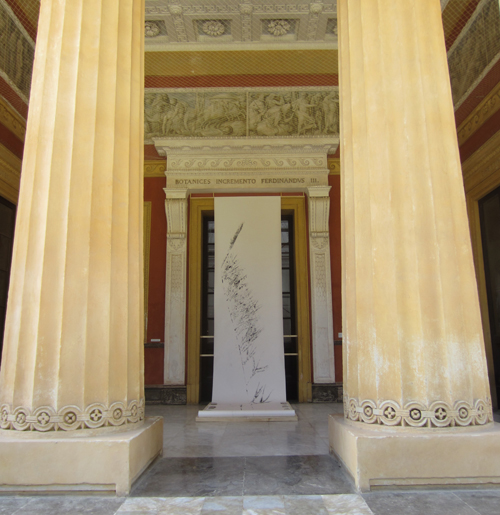

The Sicilian botanist Paolo Boccone (1633-1704) used a specific method of colouring pressed plant specimens and printing them directly onto paper, a procedure known as nature printing. As a botanist, Boccone had a particular interest in plants containing toxins that might be medically useful. His work took him on a reverse grand tour to northern Europe, where most of his nature prints are still to be found. Boccone’s early work on the uses of toxic plants can be connected to contemporary toxicological research on how ecosystems are affected by pollution, such as research on phytoremediation, which focuses on some plants’ abilities to detoxify contaminated soil and water. Phragmite Australis, or common reed, a plant often used in phytoremediation, has also been used as medicine, food and building material throughout history. At the same time, it is classified as invasive and is one of the world’s most widely spread flowering plants. In Palermo Herbal, Malin Franzén juxtaposes Boccone’s method of nature printing with contemporary scientific visualisation techniques to represent plants that coexist with toxicity, including phragmites and other plants collected at the estuary of the Oreto river and in the abandoned Parco Acqua dei Corsari in Palermo.
Palazzo Ajutamicristo
via Garibaldi 23, Palermo
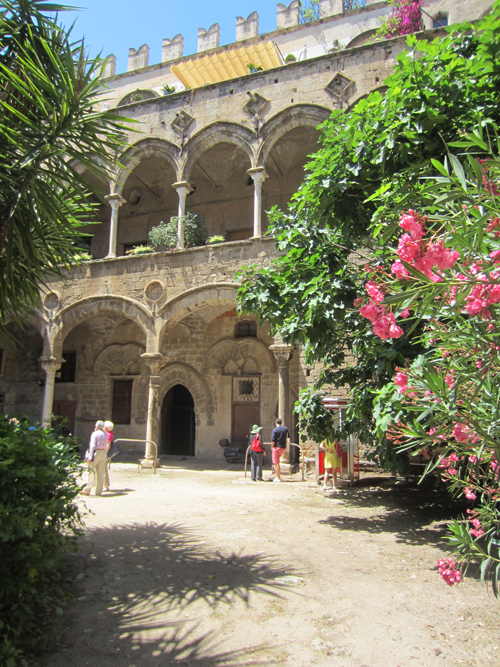

Palazzo Ajutamicristo is named after Guglielmo Ajutamicristo, baron of Misilmeri and Calatafimi, who commissioned its construction in the XV century with the aim of ensuring the control of the grain trade. In 1490 the Baron called upon the services of Matteo Carnilivari, designer of Palazzo Abatellis and the Church of Santa Maria della Catena. However the construction of the building was interrupted as early as 1495 due to financial constraints. Nevertheless, throughout the centuries, the palace has hosted illustrious visitors, such as Queen Giovanna, wife of King Don Ferrante of Naples, the Emperor Charles V, and Don Giovanni of Austria, brother of King Philip II.
After the seventeenth-century, the new owners, the Moncada princes of Paternò, commissioned changes to the palace. It now reflects Gothic-Catalan architecture with baroque balconies and portal, and a double-internal loggia with a large garden once home to the statue of the Sea Horse, now displayed in Piazza S. Spirito. In the 19th century, the Moncada’s sold the Palazzo Ajutamicristo to the Calefati of Canalotti and Tasca d’Almerita families. The Calefati still owns half the building, whilst the other half has been bought by the Region of Sicily.
In the polycentric arch portal of the original entrance, it is still possible to admire the coat-of-arms of the Ajutamicristo family.
James Bridle, Citizen Ex (2015)

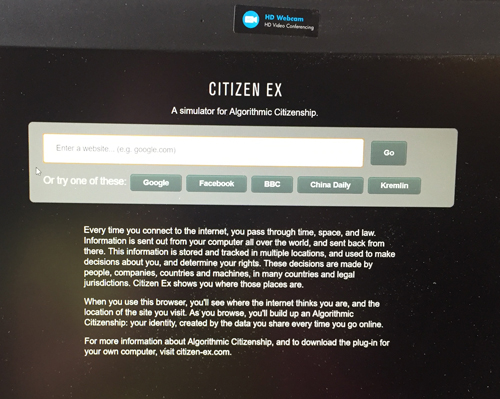
Citizen Ex, on view at Palazzo Ajutamicristo, is an installation that uses a specially conceived algorithm to show us the path made by the information – both input and output – generated each time we access the Internet. It thus deals with a very relevant topic: the storage and traceability of the data used by individuals, companies, and technologies in different countries and jurisdictions. Citizen Ex shows the places where all this takes place and demonstrates how digital actions and virtual architectures redefine geography and so-called ‘Algorithmic Citizenship’.
Tania Bruguera, Article 11 (2018)

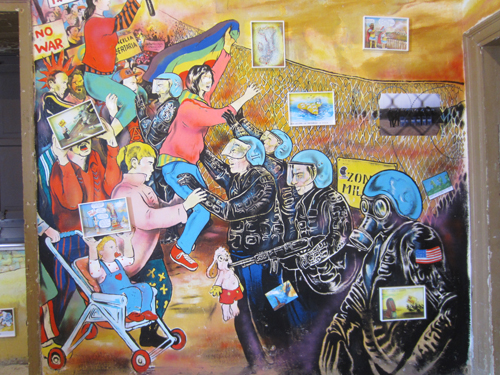
Near the small town of Niscemi in southeastern Sicily, the United States Navy has implemented a new global communication system called MUOS (Mobile User Objective System). It operates as a global cellular service provider to support war from a distance, coordinating and controlling US drones and unmanned aircraft. The base station in Sicily is one of four; the others are in Hawaii, Australia and Virginia. The location for the three gigantic parabolic antennas in Niscemi was chosen very strategically: in the middle of the last cork forest in Sicily, hidden amongst hills. Since 2009 the inhabitants of the area have been fighting against the MUOS because of the antennas’ harmful effects on human health and the environment.
Documents selected by Tania Bruguera from the activists’ archives narrate this story of an ongoing battle. Article 11 also expands beyond the realm of art. In keeping with her idea and methodology of Arte Útil she has developed a series of activities in close collaboration with the activists, trying to give them stronger visibility and voice both on a national and international level.
Filippo Minelli, Across the Border (2010 – ongoing)


Across the Border is a participatory project discussing migration and identity in the age of big data. Thirty flags were commissioned to individuals living in nations linked to each other by the migration of people, as documented in the Palermo Atlas, and by the flux of digital information via the internet’s infrastructure of underwater cables coming to and leaving from Sicily. Various performers have been commissioned to design and craft a flag locally displaying a word that in their view puts the site of the performance into relation with a different place of the world, sharing similarities with it. Flags are therefore used as a tool to connect stories, people and places rather than to define nations and their populations.
The installation on view on the top floor of Palazzo Ajutamicristo is composed of all the flags collected via the random network of performers and by the photographic documentation of the final performance realised at Palermo’s stadium.
Lydia Ourahmane, The Third Choir (2014)
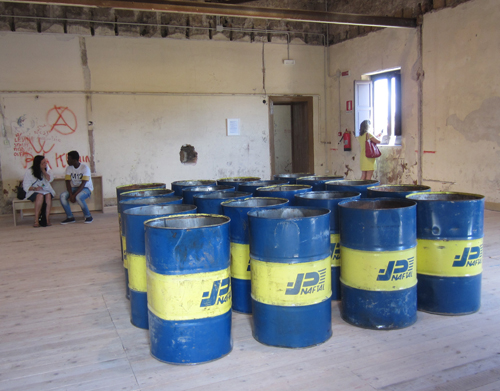

The Third Choir is a sound installation composed of twenty empty Naftal oil barrels exported from Algeria in 2014. Naftal, sold domestically in Algeria is a subsidiary of Sonatrach; which is the 2nd largest distributer of crude oil, petroleum and gas supplying to companies such as BP, Total and Chevron.
The objects convey a sense of the politics of immigration, by embodying the bureaucratic process of movement, geographically mimicking the same journey to Europe. They raise questions regarding their significance for social and political structures within Algeria, the coalitions of desire, and unrest that lead to the phenomenon of illegal immigration.
After 6 declined proposals for the export, The Third Choir became the first artwork to be legally exported from Algeria since the implementation of restrictions on the movement of art in 1962, after Algeria’s liberation from France, which was put in place to protect cultural property. This law was amended by section 75 of the Finance Act 2014 through the process of this work, and through the generous support of the Ministry of Culture.
Shown alongside a section of The Third Choir Archives, 934 documents involved in the process of exporting 20 empty oil barrels from Algeria to the UK.
Trevor Paglen, It Began as a Military Experiment (2017)
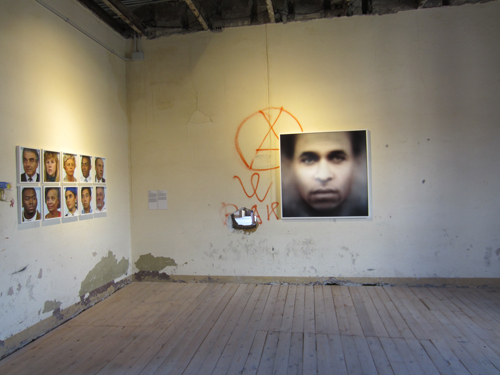
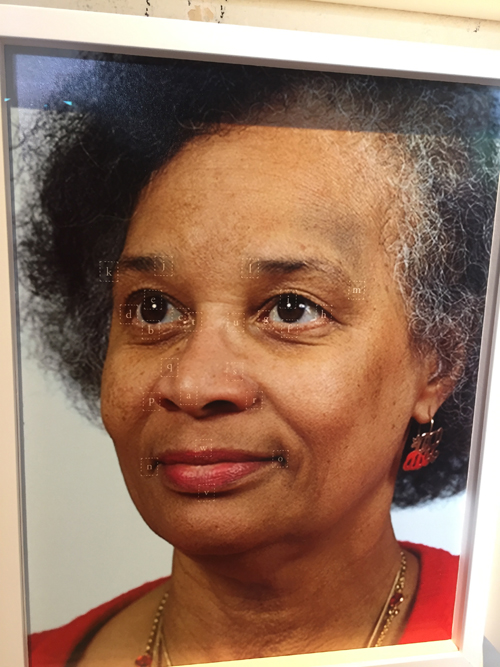
Research into facial recognition technology began in earnest in the mid-1990s at the behest of the Defense Advanced Research Projects Agency, where the military funded the creation of a database which included thousands of pictures of people. It Began as a Military Experiment, on view at Palazzo Ajutamicristo, was made by curating a selection of portraits, in order to retouch them and run them through an algorithm that identifies keypoints in the faces. It reflects on the super-structuralism attribute of these portraits, because the images were not made for human eyes but rather for machines.
To distinguish a particular person from a collection of other people, an algorithm utilises a large number of photographs to make an average that will end up as a ‘faceprint’ of that face. This practice makes it possible to use the faceprint to identify any other images of that person in the future.
“Fanon” (Even the Dead Are Not Safe) focuses on the translation of these faceprints into portraits whose ‘native’ forms are mathematical abstractions into an image that human eyes can recognise as a face.
Richard Vijgen, Connected by Air (2018)
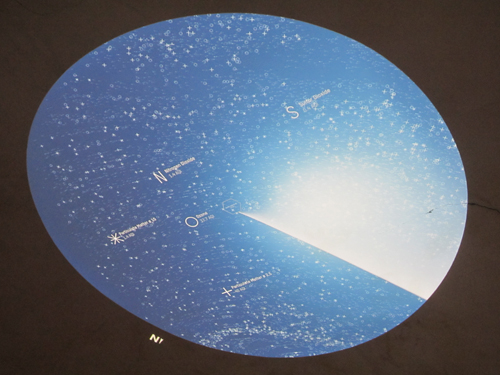
Throughout Palermo you can see the sky not only from the streets but also through the illusionistic ceiling paintings in the city’s many palaces. These paintings typically use the perspective techniques di sotto in su (paintings seen from below) and quadratura (a highly realistic perspective that extends the architectural space). Inspired by these painting techniques, Connected by Air by Richard Vijgen creates a data visualisation of the sky, di sotto in su.
The projection of Palermo’s sky on the room’s ceiling in Palazzo Ajutamicristo recreates a window that provides a comprehensive overview of all the data and objects that fill the sky, such as wireless signals, satellites, air traffic, air conditions and air flow. Connected by Air projects a contemporary sky’s image as a carrier of people, matter and information.
The Peng! Collective, Call-A-Spy (2016 – ongoing)
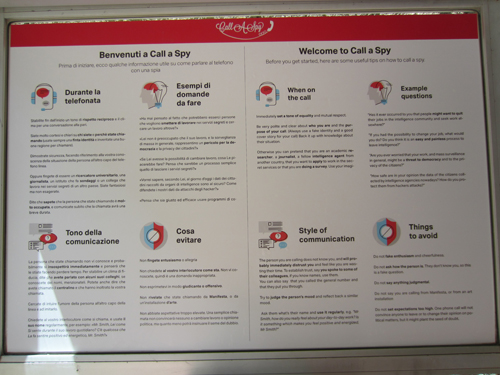
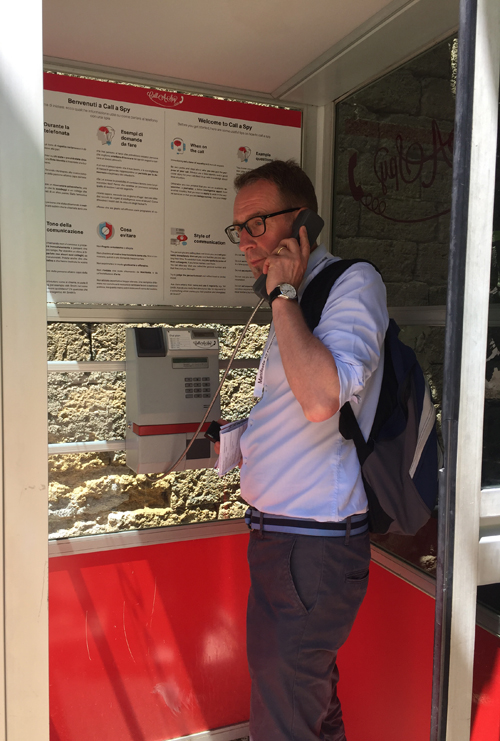
The Call-A-Spy installation provides a direct anonymous phone link to desks of employees of secret services like the NSA, FBI and Department of Home- land Security (USA), Verfassungsschutz (Germany), BND (Germany) and Direction Générale de la Sécurité Intérieure (France). Thanks to a secret database with 5,000 direct desk numbers of different intelligence agencies, the Call-A-Spy system enables the public to call spies and start a private conversation with those who surveil us, though we cannot see them.
Rayyane Tabet Steel Rings (2013 – ongoing) and Letterheads (1950-2013)


The Trans-Arabian Pipeline (TAPline) was a bold American business venture: an oil pipeline 1,213 km long that transported oil from Saudi Arabia to Lebanon through Jordan, Syria, and the Golan Heights from 1950 to 1983. The socio-political developments that later affected those areas brought about the dissolution of the company and the pipeline was abandoned. Today, this infrastructure is the only existing thing that physically manages to cross the border of five different political entities in a territory where borders are of great importance. Steel Rings is a sculpture that replicates the pipeline through 10-cm segments with the same diameter and thickness of the original pipes, each with an incision indicating its distance from the source and actual geographical coordinates. Letterheads, on the other hand, is a series of framed paper documents found in the abandoned offices of the Trans-Arabian Pipeline headquarters in Beirut. A silent series of sheets laid one beside the other form a timeline describing the rise and fall of this infrastructure.
Chiesa dei SS. Euno e Giuliano
Piazza Sant’Euno, Palermo


Chiesa dei SS Euno e Giuliano was built from 1651 to 1658 by the Confraternita dei Seggettieri (confraternity of the sedan-chair porters), which chose the two saints as the patrons of the religious brotherhood. The ‘seggettieri’ (or vastasi di cinga) were the men who carried sedan chairs, which were used to transport clients on seats set on poles. The church is composed of a single nave with two lateral altars dedicated to Madonna del Rosario and the SS. Crocifisso. The main altar was separated from the nave by means of a large arch and decorated pillars. It probably featured the altarpiece in honour of the two patron saints created by Carlo d’Anselmo, which has now been lost. The decorations are attributed to the workshop of Procopio Serpotta.
The space of the crypt contains elaborate niches arranged on three levels for the display of the bodies of the brothers, and extends below today’s Piazza Magione. A trap door leads to an underground chamber set aside for the drying of the bodies. With the advent of modern means of transport the Church of SS. Euno e Giuliano gradually fell into a state of neglect. Bombing in 1943 destroyed much of the complex, leaving it in a state of abandon. Restoration work was funded in the late 1990s by Comune di Palermo. At the edge of a large comunal square this former church invites to reflect on the long history of interdependency between religious and civic domains in Palermo.
Marinella Senatore, Palermo Procession (2018)

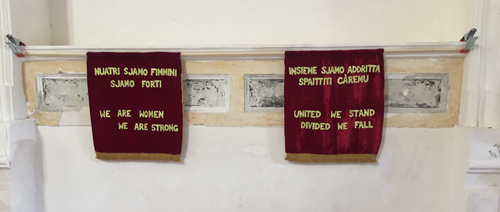
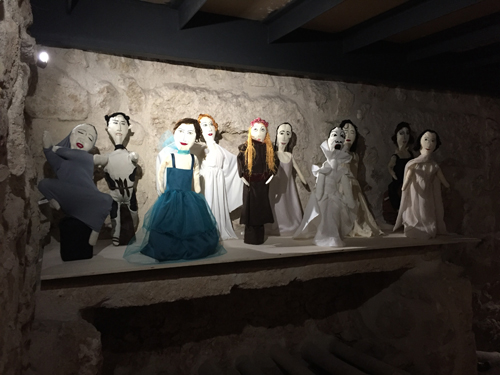
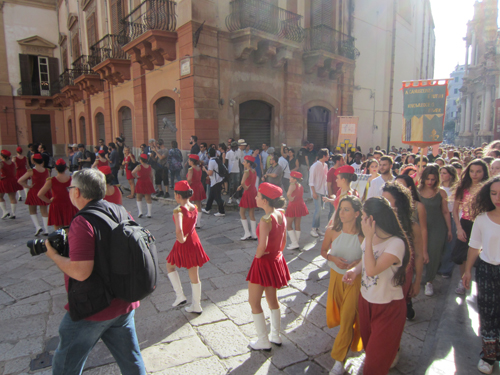

The performance Palermo Procession takes place on 16 June in the historical centre of Palermo, and the whole community is involved, from amateurs to professionals. The project focuses on the idea of narration as experience that can be explored through non-hierarchical learning, self-teaching and the creation of an active community. The procession, which sets out from Piazza Santa Chiara and arrives at the Foro Italico, reflects Palermo, a dancing city, in continuous movement. To provide a more complete vision, an exhibition at the Chiesa SS. Euno e Giuliano describes the preparatory process of participation in the procession.
Education Hub is a project of Manifesta 12 Education Department made in collaboration with the University and Academy of Fine Arts of Palermo and the transport company AMAT.

The Hub is a travelling education platform to reach out to and engage with various communities in the neighbourhoods of Palermo throughout the duration of Manifesta 12. The project is set up in a city bus, radically transformed by the students of the University of Palermo (Industrial Design) and Academy of Fine Arts (Graphic Design) under the guidance of Madrid-based architectural bureau ENORME Studio.
Chiesa di Santa Maria dello Spasimo
Piazza Carlo Ventimiglia 13, Palermo



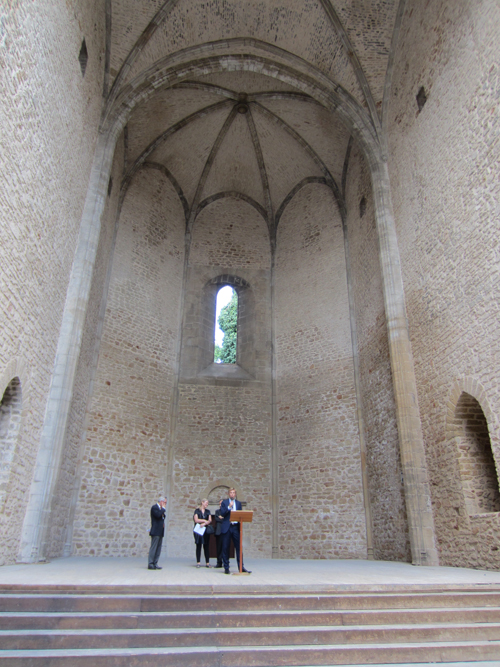
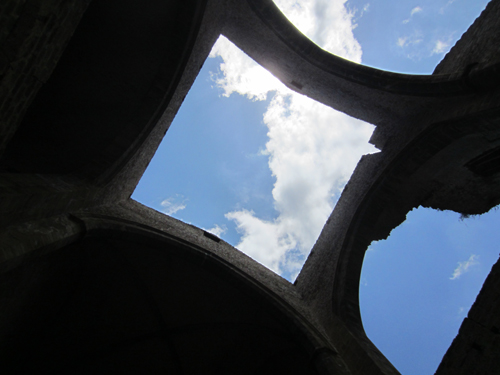
Built upon the input of the Giacomo Basilicò jurist, in 1509, to celebrate the pain of the Madonna, the church of Santa Maria dello Spasimo is one of the most evocative of all of Sicily and distinguished by a truly unique detail: it does not have a roof. The construction, which should have been completed in 6 years, took much longer than expected and the funds to support it ran short. In 1537 the danger of a possible Turkish invasion alarmed the city and inhabitants of Palermo, which immediately ran for cover and reinforced the fortifications and defence routes. The Spasimo, which was right near the entrance to the city, had to undergo changes and the monks were forced to find shelter elsewhere. In the years to follow the church, now deconsecrated, was used in various ways: from 1582 as a theater for shows; since 1624, due to the plague epidemic that struck Palermo, as a lazaretto; since 1825 as a hospice; since 1855 as a hospital; after the Second World War as a deposit of works of art from other sites. The church remained in a state of neglect until 1988, and after a lengthy restoration, in 1995 it was returned to the public. Today the entire complex is home to the Brass, Palermo Jazz school.
Cooking Sections, What Is Above Is What Is Below (2018)


Tunneling and terracing the Sicilian landscape – to channel and retain water – has led to one of the largest agricultural engines in Europe. But control over water in Sicily also gave rise to the first extortion structures back in the nineteenth century. From the qanat tunnels to contemporary ad hoc pipes that bypass the city’s infrastructure, water and politics have developed hand in hand.
What would it mean to water without water as a form of emancipation from weather? In Pantelleria, circular dry masonry walls enclose single-tree gardens and without that the citrus trees inside would never bear fruit. A series of installations set a stage around trees in Palermo to envision how to water with stones, to flourish on dry waters.
The Dutch Trail at M12






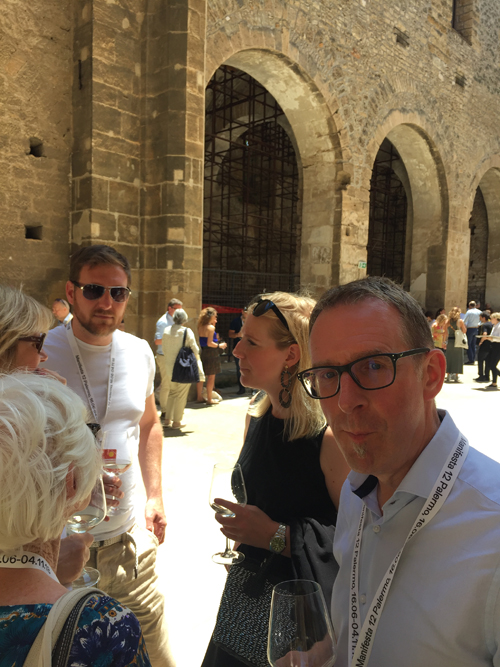
The Dutch Trail, generously supported by DutchCulture and The Netherlands Embassy in Rome, highlights a variety of Dutch participants that have contributed to Manifesta 12 Palermo in The Planetary Garden, the Collateral Events, the 5x5x5 as well as other projects related to Manifesta 12 Palermo. Indicating the various components and venues of the Dutch participants of Manifesta 12 in Palermo, the Dutch Trail encourages to discover the creative energy flowing from the Netherlands into Palermo, engaging with Europe and the world at large in a symbiotic coexistence.
Droog

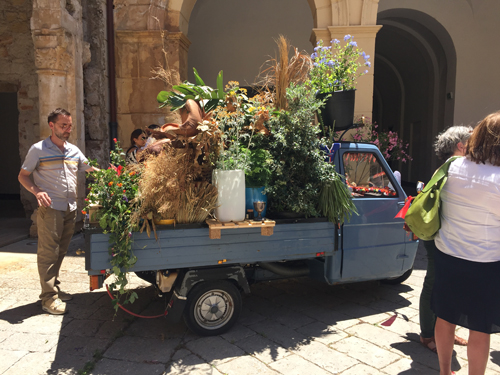
Florilegium is a performative installation produced by Dutch designer Frank Bruggeman and perfume designer Alessandro Gualtieri. Hosted by Dutch design office Droog, this project is inspired by pollination in nature and culture and took place on 15 and 16 June, 2018, at the Fontana Pretoria (Piazza Pretoria).
Giardino dei Giusti
via Alloro 80, Palermo
Cooking Sections
www.cooking-sections.com


This garden, previously known as the Bay Leaf Garden, once featured a monumental bay leaf tree, uprooted in 1704. Today, the Giardino dei Giusti is configured as an open space surrounded by the remains of the city walls bombed in WWII, a space emulating the medieval Xirbe-Arab-Norman productive gardens created in abandoned urban areas or areas buried in decomposing ruins. Inside the garden stand seven citrus trees. Inspired by the traditional Jardinu Pantesco, unusual roofed gardens typical of the island of Pantelleria, the installation by the London collective Cooking Sections offers a contemporary reinterpretation of open-air shelters created to produce a microclimate, thanks to the breeze facilitated by their shade. At the same time, and in collaboration with agronomists from the University of Palermo, the project is monitoring the health of the trees throughout the period of Manifesta 12.
Jelili Atiku, Festival of the Earth (Alaraagbo XIII) (2018)


Festino della Terra (Alaraagbo XIII) is a processional performance that incorporates festival rituals of walking with the transport of plants and soil, sound making and the carrying of sacred sculptural objects, to present allegorical and metaphorical statements on the issues of migration and immigration. Working with the concept of an allegory of plants, the work aims at redirecting attention to the essence and pivotal contributions of earth to the world. The piece borrows character and values from the history, knowledge, celebration and procession of Santa Rosalia in Palermo, but also from the ancient archetype of the Green Man, from Yoruba and West African traditional stories, myths, beliefs about earth, trees and Osain, the divine Orisha of plants.
The performance took place on 15 June 2018 in the streets of the city centre of Palermo. The documentation and the video of the procession are on view at Palazzo Costantino.
Palazzo Costantino
Via Maqueda 215, Palermo
Roberto Collovà
Giardino di giardini. Azioni sulla Costa Sud, 2018
Intervention in the public space, mixed media
As part of “City on Stage,” architect Roberto Collovà erected an office in the ruins of Palazzo Costantino.



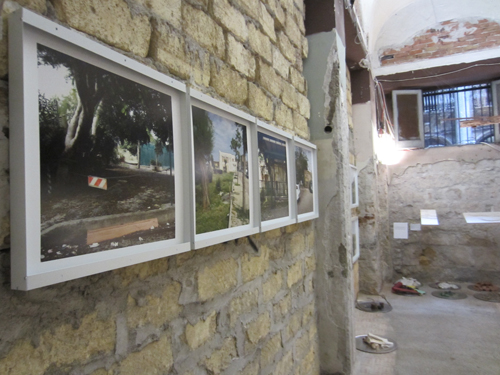

The mise-en-scène of a studio, the workplace of the architect, who puts on display models, detritus, collages, experiments, photos, drawings and maps that express a living archaeology of the south coast. The intervention is a reflection on the changes in the geography of the coast between 1950 and 1980. The habit of pouring rubble from the northward expansion into the sea created artificial promontories and wide beaches of detritus all along the coast. The popular tradition of “bathing establishments” along the 5 kilometers of the coast came to an end due to the pollution of the water and the dangerous state of the sea-beds. The two coasts, one visible and the other buried, merge into a single strip of new land. Is it possible to imagine it, from one end to the other, as a park? Part of Giardino di giardini. Azioni sulla Costa Sud becomes the project for traditional illuminations, Ponte Luminaria, that design the crossing on the stone pylons of the old railway bridge.
Fondazione “Casa Lavoro e Preghiera” di Padre Messina
via Messina Marine 1, Palermo
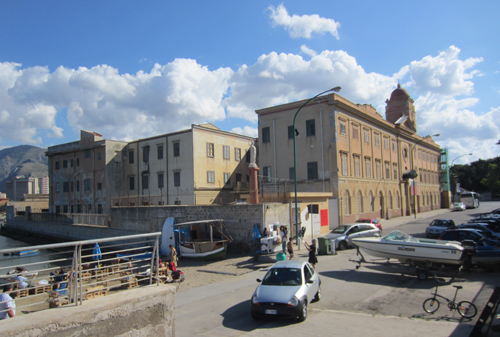


The Fondazione “Casa Lavoro e Preghiera” di Padre Messina is located in the seaside district of Sant’Erasmo and constitutes the extremity of the Kalsa district. Under the name Casa Lavoro e Preghiera, in 1900 Padre Messina created a centre for orphans and the poor inside a small storeroom in the summer residence of Prince Alessandro Tasca di Cutò, which was in a state of abandon. The space had previously hosted the historic church of Sant’Erasmo, used as burial place for victims of shipwrecks, after which it had also been used as a puppet theatre and a timber warehouse.
As the number of guests of the facility increased, Padre Messina was granted ownership of the building, and together with volunteers he personally conducted projects of expansion on publicly owned land.
Padre Messina’s charity project spread widely across the territory, following the earthquakes of Calabria-Messina and Avezzano, the great flood of Palermo in 1932, and the two World Wars, especially that of 1940-45.
Today the Fondazione “Casa Lavoro e Preghiera” di Padre Messina is the headquarters of the foundation, and provides a series of religious services and assistance activities, coordinated by the Piccole Suore Missionarie della Carità and volunteers.
Jordi Colomer, New Palermo Felicissima (2018)


For this project Jordi Colomer has created a lay procession on boats in the sea, setting out from the Caletta Sant’Erasmo and heading along the South Coast. On board are exponents of the various communities of the city of Palermo.
A video exhibited at the Istituto Padre Messina shows the route, whose various stages are described in texts specially written by the Palermo-born writer Roberto Alajmo. In urban terms, Caletta Sant’Erasmo is composed of a series of old buildings and historic architectures in a state of partial abandonment, new buildings in the outskirts, a small beach, and a quay for small ships. A combination of heterogeneous elements which allows us to define the area as a place that is suspended, but at the same time capable of serving as a territorial intermediary.
Teatro Garibaldi
Via Teatro Garibaldi 46-56, Palermo



Teatro Garibaldi was Manifesta 12 headquarter, and the venue of Manifesta 12 Public and Film Programme.
Before the opening of the biennial, a special pre-biennial programme Aspettando Manifesta 12 (Waiting for Manifesta 12) took place in the theatre. The programme invited Palermitans to pro-actively learn about Manifesta and share ideas about the future of their city.
Originally built in 1861 in the gardens of Palazzo Ajutamicristo, Teatro Garibaldi was erected at the behest of the musician and composer Pietro Cutrera as an ephemeral, rather provisional construction. The proportions of the layout conform to the architectural “rule” for “Italian-style theatres”. Newspapers of the period report that Garibaldi attended Romeo and Juliet there in 1862, declaring his famous words “O Roma, o morte” from box no. 10. After being managed by a succession of different families, alternating with periods of abandon and decline (including even hosting boxing matches), the theatre was acquired by the City of Palermo in 1983 and reopened as an active theatre in 1996 with Hamlet directed by Carlo Cecchi. Led by artistic director Matteo Bavera, Teatro Garibaldi remained active for the next decade, with productions and co-productions with Carlo Cecchi, Emma Dante, Peter Brook and Wim Wenders, who also shot a scene of his film Palermo Shooting there. In 2008, restoration work began and was completed the following year. After yet another period of neglect, during which the theatre suffered vandalism, theft and deterioration, the theatre was occupied in 2012 by a group of sixty artists, workers and performers until 2014, when it was entrusted to Matteo Bavera for seven months. It reopened in 2017 as the headquarters of Manifesta 12.
City Scripts by Giorgio Vasta
City Scripts takes form starting with a city, Palermo, made of space and time, and five narrators, three of which are single – Fulvio Abbate, Emma Dante and Giorgio Vasta – and two of which are plural, young people from twenty to twenty- five years of age, from Italy and Africa, who now live in the city. City Scripts is the description of five fragments of Palermo, five texts that will be made available as free podcasts, five ‘visions for listening’, five perceptions of the space of the city over time (past and future), five micro-narratives in which the wordscape mingles with the soundscape.

All Podcasts available on http://m12.manifesta.org/city-scripts/
Piazza Magione


Along with Teatro Garibaldi, the nearby Piazza Magione will provide an extension of the activities launched by the theatre during summer months and will be used as an open-air stage for community-based projects, summer cinema and artistic intervention in public space.
The piazza, named after the homonyms Basilica La Magione on the south-east side of the square, is located in close proximity to Teatro Garibaldi. During the Arab dominance of Sicily, the square was reputedly a lush garden of the Fatimide dynasty. It was significantly damaged by World War 2 bombings, including a complete destruction of the square’s surrounding palazzos. In recent years, the City of Palermo has carried out renovations in Piazza Magione, including a new soccer field for the neighborhood, and a central meadow with pedestrian pathways built on restored foundations of pre-existing buildings. Manifesta 12 will attempt to further contribute to the revitalization of the square as a neighborhood meeting point, through temporary and long-term interventions.


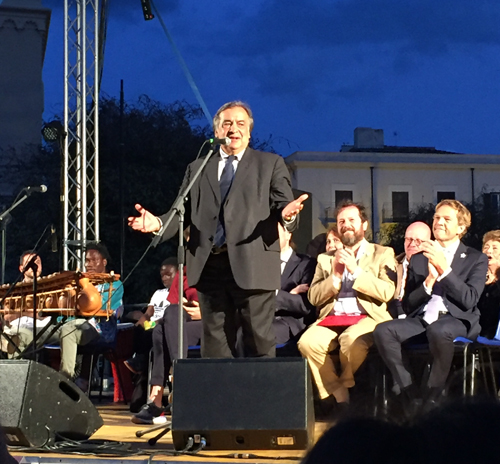




Other places to visit:
Quattro Canti
Via Vittorio Emanuele & Via Maqueda, Palermo

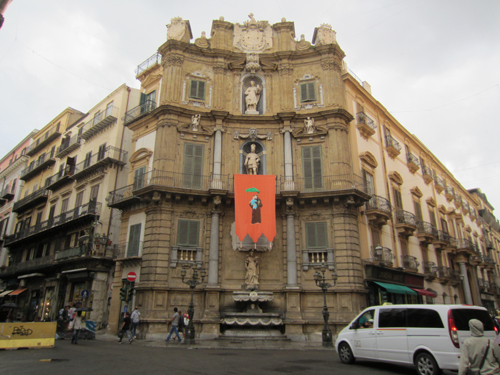
Quattro Canti, officially known as Piazza Vigliena, is a Baroque square and was laid out on the orders of the Viceroys between 1608-1620 by Giulio Lasso at the crossing of the two principal streets in Palermo, the Via Maqueda and the Corso Vittorio Emanuele.
The piazza is octagonal, four sides being the streets; the remaining four sides are Baroque buildings, the near-identical facades of which contain fountains with statues of the four seasons, the four Spanish kings of Sicily, and of the patronesses of Palermo, (Christina, Ninfa, Olivia and Agata). The facades onto the interchange are curved, and rise to four floors; the fountains rise to the height of the second floor, the third and fourth floors contain the statues in niches. At the time the piazza was built, it was one of the first major examples of town planning in Europe.
Chiesa di Santa Caterina d’Alessandria
Piazza Bellini 2, Palermo
provincia.palermo.it



The Church of Saint Catherine is an important church of Palermo. It is located in the heart of the historic centre, between Piazza Bellini and Piazza Pretoria, in the same area of other well-known architectural landmarks like the churches of Martorana and San Cataldo, the Fontana Pretoria and the Palazzo Pretorio, headquarters of the Palermo municipality. The church is a synthesis of Sicilian Baroque, Rococo and Renaissance styles.
La Martorana – Santa Maria dell’Ammiraglio
Piazza Bellini 3, Palermo
www.summerinitaly.com
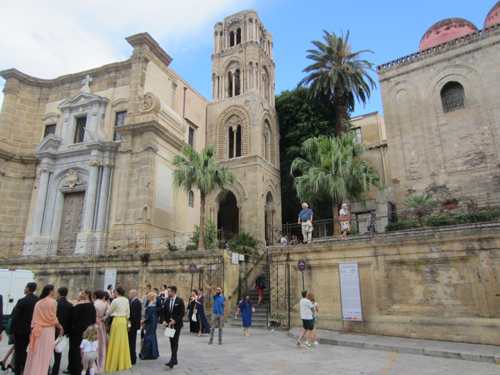

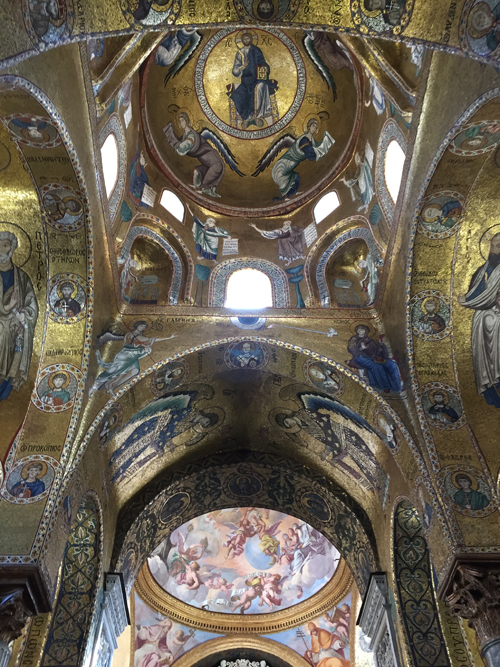

On the southern side of Piazza Bellini, this luminously beautiful 12th-century church was endowed by King Roger’s Syrian emir, George of Antioch, and was originally planned as a mosque. Delicate Fatimid pillars support a domed cupola depicting Christ enthroned amid his archangels. The interior is best appreciated in the morning, when sunlight illuminates the magnificent Byzantine mosaics.
In 1433, the church was given over to an aesthetically challenged order of Benedictine nuns – founded by Eloisa Martorana, hence its nickname – who tore down the Norman apse, reworked the exterior in a fussy baroque fashion and demolished most of the stunning mosaics executed by Greek artisans, replacing them with the gaudy baroque ornamentation of their own frescoed chapel. The few remaining original mosaics include two magnificent portraits, one representing George of Antioch, crouched behind a shield at the feet of the Virgin Mary, and one of Roger II receiving his crown from Christ (the only portrait of him to survive in Sicily).
Mussolini returned the church to the Greek Orthodox community in 1935, and Greek Mass is still celebrated here. (www.lonelyplanet.com)
Chiesa di San Cataldo
Piazza Bellini 1, Palermo
www.ilgeniodipalermo.com and whc.unesco.org


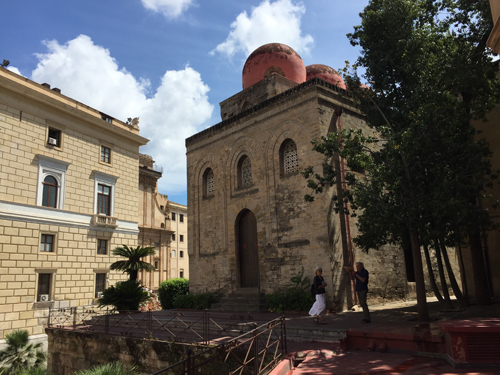
The church of San Cataldo was also constructed by an Admiral of the Kingdom, Maio of Bari, who made it the private chapel of his palace, built on the ruins of the ancient Punic-Roman walls. It was founded in the mid-twelfth century, although its current appearance is very different from its original one, as Maio’s palace incorporated the chapel, and has been reworked substantially over the centuries.
Fontana Pretoria
Piazza Pretoria, Palermo



Fringed by imposing churches and buildings, Piazza Pretoria is dominated by the over-the-top Fontana Pretoria, one of Palermo’s major landmarks. The fountain’s tiered basins ripple out in concentric circles, crowded with nude nymphs, tritons and leaping river gods. Such flagrant nudity proved a bit much for Sicilian churchgoers, who prudishly dubbed it the Fontana della Vergogna (Fountain of Shame).
Designed by the Florentine sculptor Francesco Camilliani between 1554 and 1555 for the Tuscan villa of Don Pedro di Toledo, the fountain was bought by Palermo in 1573 and proudly positioned in front of the Palazzo Pretorio (Municipal Hall) in a bid to outshine the newly crafted Fontana di Orione installed in Messina. (www.lonelyplanet.com)
Palazzo Delle Aquile or Palazzo Pretorio
Piazza Pretoria, Palermo
en.wikipedia.org


The Praetorian Palace (Italian: Palazzo Pretorio), also known as Palace of the Eagles (Italian: Palazzo delle Aquile), houses today the Cityhall of Palermo. The building has an important role in the political life of the city, since it houses the mayor and the offices of the municipality of Palermo. It is located in the heart of the historic centre, between Via Maqueda, Piazza Pretoria and Piazza Bellini, in the same area of other well-known architectural landmarks like the Fontana Pretoria, the Baroque church of Santa Caterina and the Medieval churches of Martorana and San Cataldo (both of them are World Heritage Sites).

During our visit, the Cityhall raised the flag of The Netherlands, since the Manifesta organisation is mainly housed in The Netherlands. Unfortunately, they had little knowledge about how the flag should look like and had it up side down, blue white and red instead of red white and blue. Even after I commented it to the staff and the guards, they looks up, made phone calls but didn’t dare to change it. Luckily, they had corrected it the day after!
Foro Italico

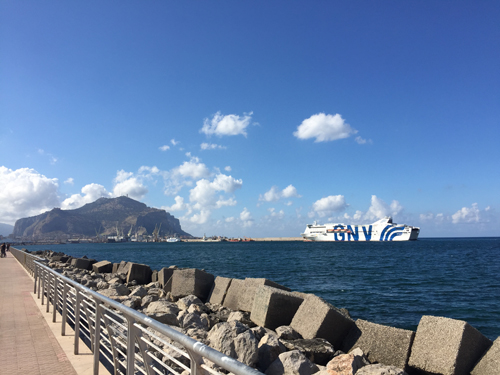




The Foro Italico is a lawn along the seafront of Palermo.
In 1582 Vice-King Marco Antonio Colonna created a walking path in this part of the coast, that became a favorite destination for the leisure of the upper classes of the city in the 17th and 18th centuries.
It is entirely pedestrian, with Mediterranean flora of various kinds, benches, trees, ceramic sculptures, a bike path, night lighting and a wide scenic walk along the coast. It was redeveloped in 2003, when, the lawn, the pedestrian paths, the public lighting and an irrigation system were improved.
Cattedrale di Monreale
Piazza Guglielmo II 1, Monreale



Monreale is a town and comune in the Metropolitan City of Palermo. It is located on the slope of Monte Caputo, overlooking the very fertile valley called “La Conca d’oro” (the Golden Shell), a production area of orange, olive and almond trees, the produce of which is exported in large quantities. The town is about 15 kilometers inland (south) of Palermo, the regional capital.

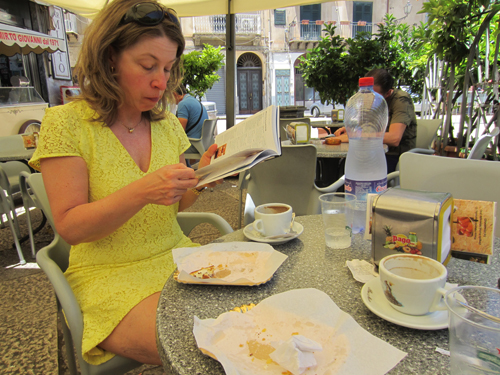

Monreale is home to a historical Norman-Byzantine cathedral. This has been designated as one of several buildings named in a UNESCO World Heritage Site, a group of nine inscribed as Arab-Norman Palermo and the Cathedral Churches of Cefalù and Monreale.



The Cathedral of Monreale or Duomo di Monreale is a church in Monreale, Metropolitan City of Palermo. One of the greatest existent examples of Norman architecture, it was begun in 1174 by William II of Sicily. In 1182 the church, dedicated to the Nativity of the Virgin Mary, was, by a bull of Pope Lucius III, elevated to the rank of a metropolitan cathedral.
The church is a national monument of Italy and one of the most important attractions of Sicily. Its size is 102 meters long and 40 meters wide.
Mondello




Mondello is a small borough of the city of Palermo in the autonomous region of Sicily in Southern Italy.

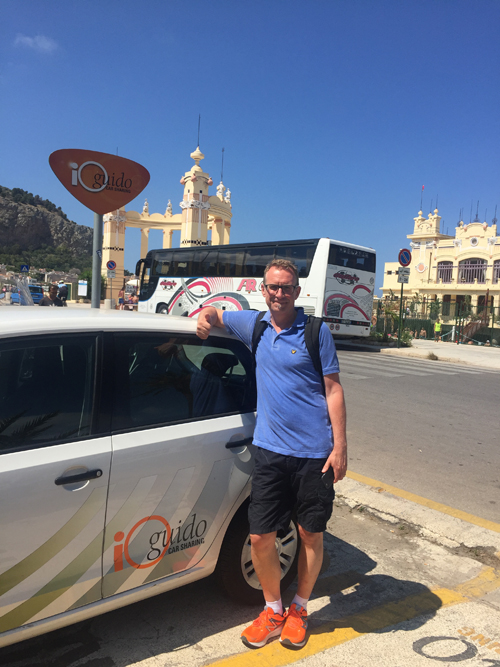
Its beach lies between two cliffs called Mount Gallo and Mount Pellegrino. The town was originally a small fishing village situated on marshland, but at the end of the 19th century it grew into a tourist destination. A number of Liberty style villas on the seafront promenade have made it one of the gems of Art Nouveau in Europe.
Places to shop:
Tessuti Tessutini Tessutoni
Via Lincoln 41, Palermo
Faceboook – Tessuti Tessutini Tessutoni



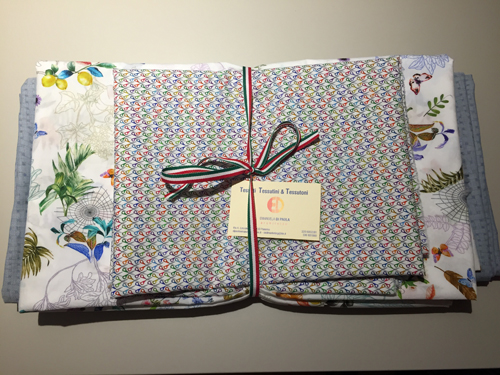
Places to eat or drink:
Osteria Ballarò
Via Calascibetta 25, Palermo
osteriaballaro.it




A slinky, buzzing restaurant-wine bar, Osteria Ballarò marries an atmospheric setting with sterling, Slow Food island cooking. Bare stone columns, exposed brick walls and vaulted ceilings set an evocative scene for arresting crudite di pesce (local sashimi) and seafood primi, elegant local wines and memorable Sicilian dolci (sweets). Reservations recommended. Slow Food recommended. (lonelyplanet.com)
Buatta Cucina Popolana
Via Vittorio Emanuele 176, Palermo
www.buattapalermo.it




A lively restaurant housed in the historic rooms of an old shop, where the traditional dishes change regularly in line with the seasons. Highlights include the bucatini alle sarde (pasta with sardines) and fish involtini.
(MICHELIN guide inspectors)
Casa Obatalà
Via Alloro 16, Palermo
Great place for early coffee on their outdoor terrace!


Ristorante Quattro Mani
Via Francesco Riso 3, Palermo
www.ristorantequattromani.com


The restaurant is located at piazza Magione, within the Kalsa neighbourhood, in Palermo. A sincere cuisine, dedicated to Sicilian homely tradition.
All of their ingredients come from entirely organic, free trade supply chains, sourced almost exclusively in Sicily. A list of their suppliers is available on their website.
Friggitoria Chiluzzo
Piazza della Kalsa 11, Palermo
instagram.com – Friggitoria Chiluzzo

Enotequa
Via Maqueda 274, Palermo
Instagram – Enotequa

Touring Cafè Beach
Viale Regina Elena 17, Mondello – Palermo


If you are visiting Palermo, Touring Cafè Beach is a must-see stop, thanks to the specialty that makes it famous throughout the city: “arancina bomba”. The specialties of the Rotisserie and pastry cakes are the strong points for this bar.
Located in the hotspots of Palermo tourism, including Mondello in front of the beach, in the historic center of Palermo, Via Lincon in front of the famous Villa Giulia, and finally in Via Roma, a stone’s throw from the church of San Domenico and Via Alcide de Gasperi near Stadium Renzo Barbera.
Badalamenti Cucina e Bottega
Viale Galatea 55, Mondello – Palermo
www.badalamenticucinaebottega.it
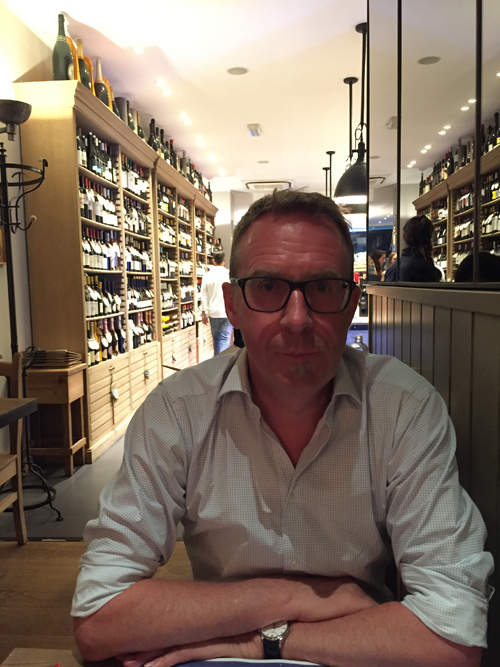
Badalamenti Cucina e Bottega is a place that offers the best of Sicilian cuisine, with top quality products cooked according to traditional recipes: homemade pasta, soups, fish and shellfish, tasty meat dishes and mixed cutting boards from selected wines. Among the many specialties of the house, the eggplant supplì, fish tartare, lamb chops and much more.
As happened in the premises of the past, from Badalamenti Cucina and Bottega in Palermo it is possible to buy food products in the sales area, where you can also have a pleasant snack break with tasting.
Places to stay:
de Bellini Design Apartments
5, Piazza Bellini in Palermo
debellinipalermo.it
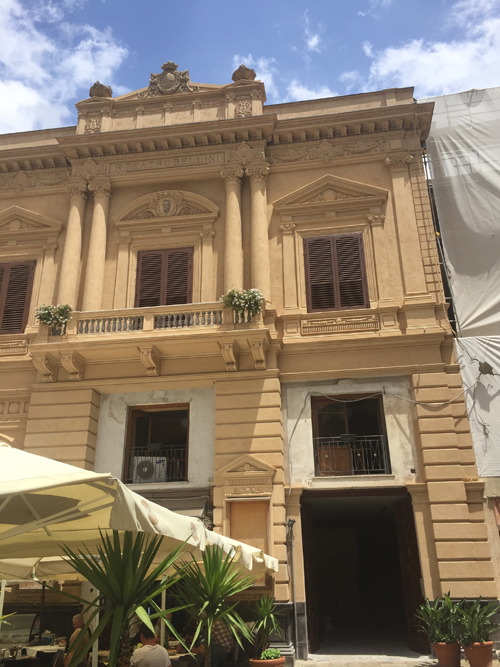
Entrance om Piazza Bellini
During the weekend, we stayed at this beautiful place at the Piazza Bellini, close to Fontana Pretoria, Via Roma and Via Vittorio Emanuele. We made the booking through Booking.com.
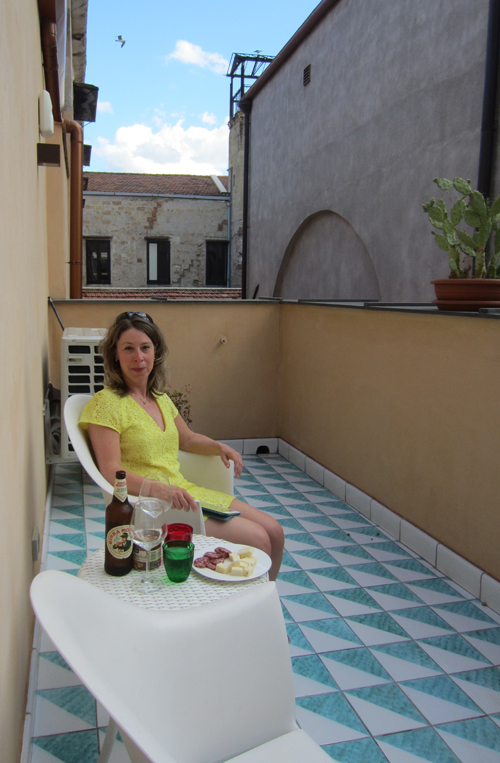

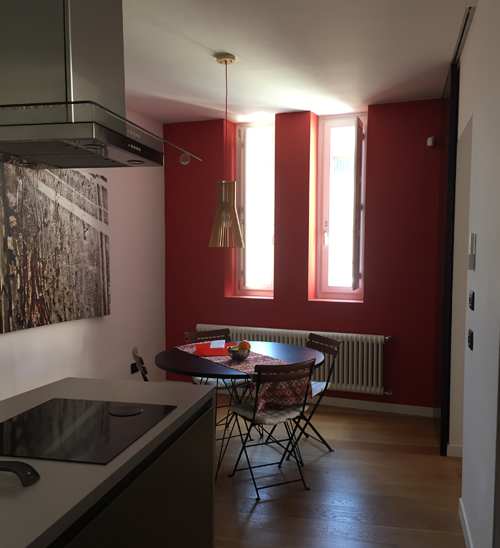
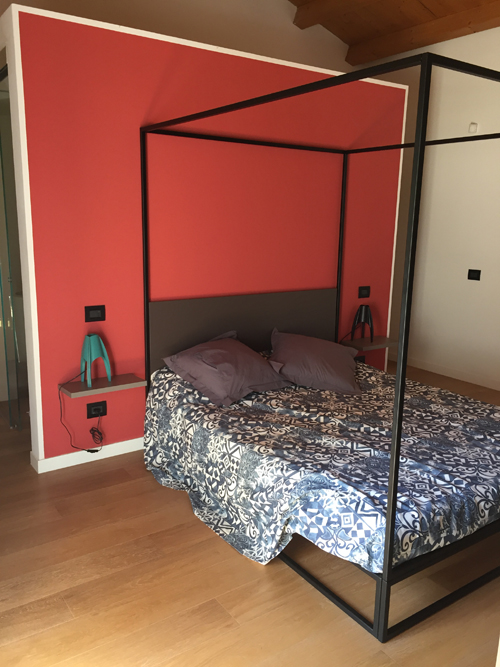
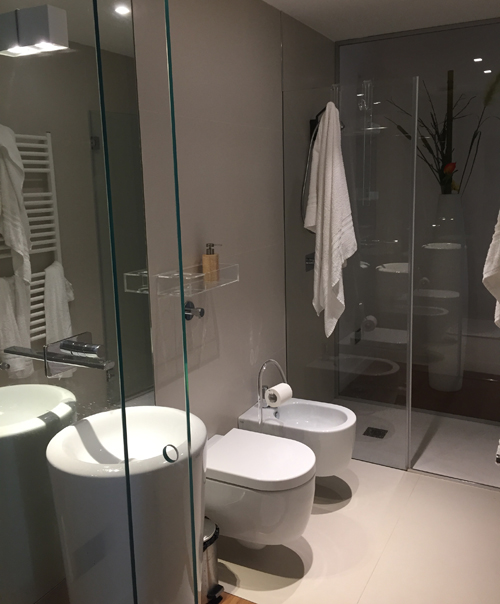
We stayed in the Bellini’s Balcony apartment, with the magic view on the Piazza. This is the most prestigious apartment in terms of layout and views. It contains a spacious living area comprising a large dining room, a modern kitchen and a toilet. A window in the upper section frames one of the most enchanting views of the Chiesa della Martorana.
A large walk-in closet separates a small study area from the enchanting sleeping area containing a modern, wrought iron canopy bed and a luxury glazed bathroom.
There’s a small private terrace with a close-up view of the Martorana in all its glory, where you can enjoy an al fresco breakfast in the warm Palermo sunshine.
There’s also a balcony overlooking the internal courtyard, with a bird’s eye view of the archaeological excavations carried out on the lower floors; a peaceful spot for quiet moments.
Villa Flora
Via Locarno 8, Mondello PA
bbvillaflorapalermo.it


Villa Flora is located at 2,5 km from the beach of Mondello-Waldensian, a picturesque fishing village, famous for the prestigious Art Nouveau villas and the warm, clear waters of the sea. The historic center of Palermo, is 8 km from the airport takes just 40 minutes (27km).



 Posts
Posts